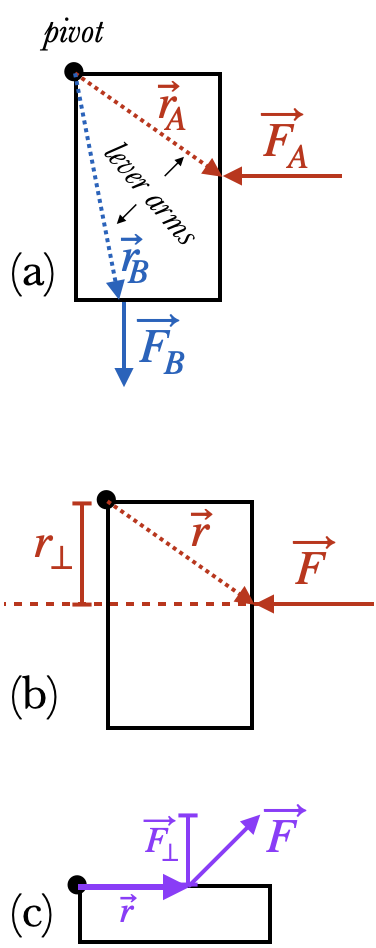25. (Problem Solving)
Torque Problems
Calculating torque of a force $\vec F$
- Choose the pivot.
- Draw the lever arm $\vec r$ from the pivot to the point of contact. (Each force has its own lever arm: see (a).)

Consider special cases:
- if the force points directly at or away from the pivot, then the torque is zero
- if the force and lever arm are perpendicular to each other, then the torque is $\tau = rF$
- If you are given the angle $\theta$ between $\vec r$ and $\vec F$, then $\tau = rF\sin\theta$
- if the force is "level" (i.e. lies along an axis), draw a line through the force vector, and then measure the shortest distance from the pivot to that line. That is $r_{\perp}$, and the torque is $\tau = r_{\perp}F$ (See (b)).
- if the lever-arm is level, then find the component of the force $F_{\perp}$ that is perpendicular to the lever arm. Then torque is $\tau = rF_{\perp}$ (See (c)).
- Finally, add the sign:
- $+$ if the torque points counterclockwise around the pivot,
- $-$ if the torque points clockwise
Solving Torque Equilibrium Problems
- Draw a force diagram and create a force table. Add a column for torque.
- Fill out the force table's $x$ and $y$ columns as usual
- Don't forget any force from the pivot or hinge. (Call it a normal force.)
- Calculate the torque for each force.
- I recommend writing it as $(r)(F)$ rather than multiplying it out right away, to make it clearer what you're doing.
- Always include the sign.
- The torque column must add to zero as well.
- There will be three equations for three columns, so you can solve for three unknowns.